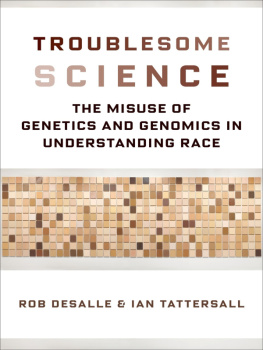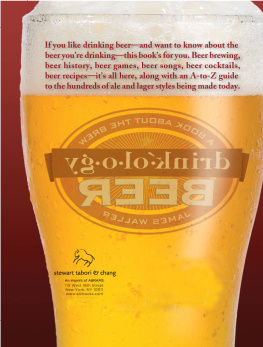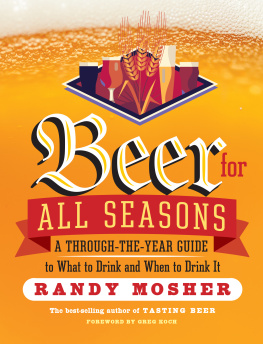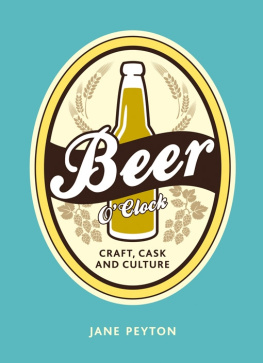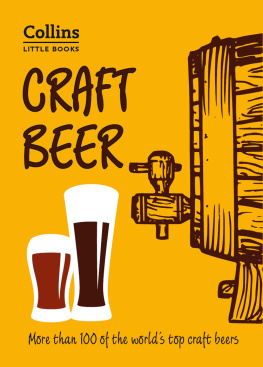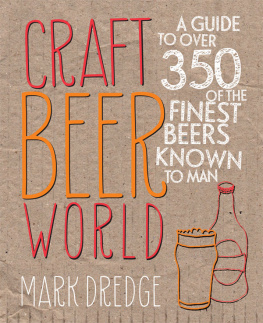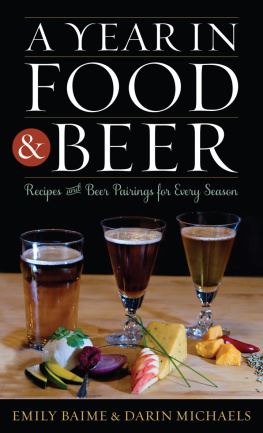A Natural History of Beer
A Natural
History of
Beer
ROB DESALLE &
IAN TATTERSALL
Illustrated by Patricia J. Wynne


Published with assistance from the Louis Stern Memorial Fund.
Copyright 2019 by Rob DeSalle and Ian Tattersall.
Illustrations copyright 2019 by Yale University.
All rights reserved.
This book may not be reproduced, in whole or in part, including
illustrations, in any form (beyond that copying permitted by
Sections 107 and 108 of the U.S. Copyright Law and except by
reviewers for the public press), without written permission from
the publishers.
Yale University Press books may be purchased in quantity for
educational, business, or promotional use. For information, please
e-mail
(U.K. office).
Designed by Mary Valencia.
Set in Baskerville and Avenir type by
Tseng Information Systems, Inc.
Printed in the United States of America.
Library of Congress Control Number: 2018951186
ISBN 978-0-300-23367-4 (hardcover : alk. paper)
A catalogue record for this book is available
from the British Library.
This paper meets the requirements of ANSI/NISO Z39.48-1992
(Permanence of Paper).
10 9 8 7 6 5 4 3 2 1
Illustration on frontispiece and title pages: iStock/micropic
To Erin and Jeanne,
even though they prefer wine
Contents
Preface
B eer is possibly the worlds oldest alcoholic beverage, and it is certainly the most important historically. What is more, although beer has tended to lag behind wine in public esteem, in its more inspired manifestations it has at least as much to offer as wine does to our five senses, and to our human capacity for aesthetic appreciation. Indeed, it has been argued that beer not only is both conceptually and operationally more complex than its rival, but also can offer a more complete expression of its makers intentions. None of this means, of course, that we lack enthusiasm for wineas we hope any reader of our book A Natural History of Wine will immediately understand. Wine occupies a unique and important place in human experience, and in our own lives. But then again, so does beer; and it is clear to us that the two beverages, while complementary, are wholly distinct. If one of them merits consideration from a natural history perspective, so does the other.
Hence this book, which appears in a golden age for beer drinkers virtually everywhere. True, the recent excitement in craft brewing has unfolded against a monolithic backdrop of rather uniform mass-market beers, produced and sold in mind-numbing quantities by international giants. But at the more innovative end of the market, beers have never been produced in such variety and with such amazing inventiveness. The abundance of creative new offerings has had the effect of making the world of beer not only an exciting place but a rather confusing one as well, with an almost incomprehensible riot of consumer choice available through an archaic distribution system that makes many well-reputed beers hard to find. But sometimes a bit of anarchy can be exhilarating.
There are plenty of publications that will help you navigate the chaos, though frankly the craft is developing so fast that it is a full-time job just to keep up. Our intention here, though, is very different. Our goal is to show just how complex the identity of beer is, by situating it first in its historical and cultural contexts, and then in the setting of the natural world from which both its ingredients and the human beings who make and drink it have emerged. In the process, we traverse evolution, ecology, history, primatology, physiology, neurobiology, chemistry, and even a bit of physics, in the hope of offering a more complete appreciation of the wonderful pale-straw-to-blackish-brown liquid that reposes in the glass in front of you. We hope you will find the journey as enlightening as we did.

This book was enormous fun to write, and even more fun to research. For help with the latter, we must thank many good friends and colleagues. Among them we wish particularly to mention Heinz Arndt, Mike Bates, Gnter Bruer, Annis Cordy, Mike Daflos, Patrick Gannon, Marty Gomberg, Sheridan Hewson-Smith and the University Club of New York City, Chris Kroes, Mike Lemke (who originally taught RD to homebrew, two decades ago), George McGlynn, Patrick McGovern, Michi Michael, Christian Roos, Bernardo Schierwater, and John Trosky. We also want to express our appreciation to our favorite drinking establishments in New York City. There are many, but among them ABC Beer Company, The Beer Shop, Carmine Street Beers, and Zum Schneider come particularly to mind, just as the old West 72nd Street Blarney Castle and its incomparable host Tom Crowe remain a fond memory.
At this point in our careers we can hardly imagine producing a book without both the art and the moral support of Patricia Wynne, who is always at least as much collaborator as illustrator. Thank you, Patricia, for the pleasure of working with you, both on this project and over the years.
At Yale University Press we are above all indebted to our longtime and frequently long-suffering editor Jean Thomson Black, without whose energy, encouragement, and enthusiastic support this book would never have gone forward. We would also like to express our gratitude to Michael Deneen, Margaret Otzel, and Kristy Leonard for help with production and contract matters, Julie Carlson for her excellent copyediting skills, and Mary Valencia for the books elegant design.
Finally our thanks are due, as ever, to Erin DeSalle and Jeanne Kelly for their patience, forbearance, and good humor at all stages of the books gestation.
PART ONE
Grains and Yeast
A MASHUP FOR THE AGES
1
Beer, Nature, and People

If a howler monkey could get happily sloshed, then so could we. White Monkey, said the label on the tall bottle, the eponymous primate having apparently presided, hands across eyes, over the three-months-long aging of this Belgian-style tripel in white wine barrels. Eyes open, we unwound the wire cage, popped out the Champagne-like cork, and admired the bubbles lazily rising through the golden-amber ale. Those wine barrels were subtly detectable on the nose, but the beer hit the palate as a classic harmonious tripel, with sweet malty tones and a decadent finish. We hoped the original drunken howler monkey had enjoyed his fermented Astrocaryum fruits half as much!
H uman beings may be the only creatures who make beer. But if we take a broad view of what beer is, they are not the only creatures who drink it. As any thirsty paleontologist who has scoured the torrid Arabian landscape with only a pallid near beer to look forward to at the end of the day will tell you, the key ingredient of this marvelous beverage is ethyl alcohol. Yet there is nothing intrinsically amazing about this simple molecule, which turns out to be astonishingly widely distributed in nature. Vast clouds of it, for example, swirl around the center of our Milky Way galaxy, giving rise to what our colleague Neil deGrasse Tyson has called the Milky Way Bar. Far surpassing anything in the famous bar in the first
Next page

